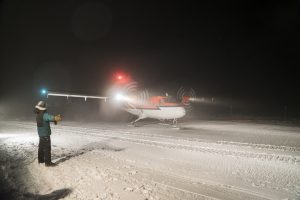South Pole Medical Evacuation Flight
During my ongoing literature review I often discover interesting facts about things I’ve never thought about. Sometimes I can connect these facts with my own observations: The result is mostly a completely new idea why things are as they are. Maybe these ideas are new to you, too. Therefore I’ll share my new science based knowledge with you!
This week: This time, I think about the risky South Pole medical evacuation flight that took place this week in order fly two patients out of Antarctica for medical treatment unavailable at the remote research station.
Overwintering at one of the research station that are built in Antarctice is, despite all the technologically advanced equipment, still a challenging task. The crews are isolated in their remote stations for about 9 months during which they can not get new supplies or any other help in case of a problem. Amongst other things, fire is one of the biggest threats as it can severely damage the infrastructure which protects the crew members during the long polar winter. Another threat can be severe injuries or deseases as, due to the harsh environment, evacuations are very risky and mostly impossible. Therefore, each research station also features a small hospital that allows the stations‘ physicians to treat most of the injuries and deseases that can occur.
However, this was not possible for one of the workers who stayed at the Amundsen-Scott South Polar station this austral winter as this crew member required a level of medical care that is not possible at the station’s hospital. Therefore, officials with the Nation Science Foundation decided to launch a medical evacuation flight in order to fly this patient out of Antarctica for the much needed medical treatment which is unavailable at the remote station.

A Twin Otter aircraft on a medical evacuation flight taxis on the skiway at NSF’s Amundsen-Scott South Pole Station.
Credit: Robert Schwarz, National Science Foundation.
A medical evacuation flight during the strong polar winter is everything but a simple task. During the winter, temperatures can be that low that fuel becomes a slush, thus requiring the fuel to be heated before and during the flight. Also, the low temperatures pose a threat for the hydraulic systems of a C-130 Hercules aircraft that would normally be the perfect choice for such a mission. The only airplane that is built for flying in very low temperatures is the Twin Otter which already was used for two previous mid winter evacuation flights conducted by Kenn Borek Air. Until the first winter flight in 2001, it was considered as impossible due to the very low temperatures and the rapidly changing weather in Antarctica.
The medical evacuation flight began with the long journey of two Kenn Borek Air Twin Otter airplanes from Canada to the British Rothera base on the Antarctic Peninsula. While one of the two aircrafts began the 10-hour long flight to the Amundsen-Scott station, which is more than 2400km away from Rothera base, the other Twin Otter remained at Rothera in case of search-and-rescue mission. In addition to the very long distance and the harsh weather conditions, the flight takes place in the permanent darkness of the long polar night.
Aside from the environmental conditions, this flight is especially challenging as the Twin Otter is the only aircraft that will be flying over Antarctica at this time. Also, the with huge additional tanks equipped Twin Otter can fly for 12 hours and thus, after the first 6 hours of flight, the pilots reach the famous point of no return. After this time, they do not have enough fuel on board to return to the station where they began their flight.
Luckily, everything went flawlessly and the Twin Otter made it to the Amundsen-Scott station on June 21st and, after a 10-hour long rest period, the aircraft successfully returned with two sick patients to Rothera base on June 22nd.
This medical evacuation flight was an impressive demonstration of collaboration, technology and endurance.